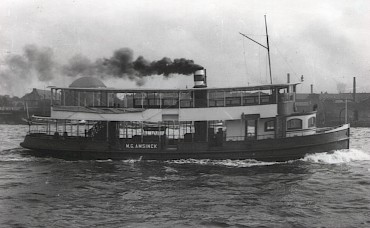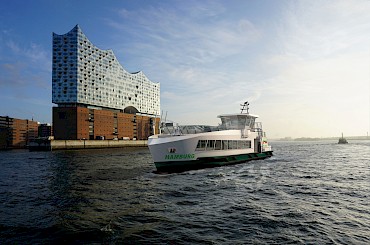1888 was a real turning point for Hamburg: as well as becoming part of the German Empire’s customs system, the city opened the Speicherstadt and the free port. What’s more – and this is the best bit – 1888 also ushered in a “regular steam ferry connection for the Elbe free port”. That was the objective of the ferry contract signed between Hafen-Dampfschifffahrt A.-G. and the senate on 08/08/1888, and the vision of HADAG’s founder, Ernst Hadenfeldt. Up to that point, there had been countless boatmen and ferry companies operating alongside one another at the port. It was time to put an end to the chaos!
The Port of Hamburg was not just one port but many, each with a specific purpose. They included the India-Hafen and Strand-Hafen, Petroleum-Hafen and Baaken-Hafen, Oberhafen and Zollhafen. All in all, there were more than 38. Thousands of workers needed to travel each day to the shipyards, fruit warehouses and quay walls. It took a lot of people to run a world-class port: workers to clean the boilers and ships, vessel painters and machinists, dockers and winch operators. The HADAG skippers were also at the centre of the action. While rowing boats might seem like a nice idea, they’re not much fun in gale-force winds. From 1888 onwards, a single fleet put things on the right tack. The first route was the Zollkanal line, stopping at St. Pauli Landungsbrücke, Roosenbrücke (Baumwall), Kajen (Rödingsmarkt), Mattentwiete (Brooksbrücke), Steckelhörn (Zippelhaus), Wandrahmsbrücke (Meßberg), Deichtor, Stadtdeich, Brandshofer Schleuse, Elbbrücke and Veddel. By 1893, six more lines had been added. The number then grew further and today there are eight.
When the Kaiser abdicated in 1918, the city took the rudder. The senate has sat astern ever since. HADAG expanded its portfolio. The vessels that weren’t needed during the day started taking visitors on harbour tours. Soon, they started going as far as Cuxhaven, Heligoland and even the Caribbean. Admittedly, it took a while for us to venture as far as the Caribbean – and we didn’t do it with a steamer.







